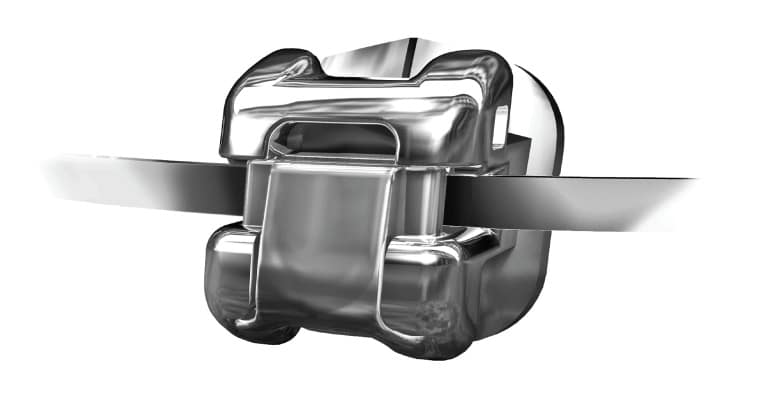
Damon Braces—also known as the Damon System—represent a revolutionary approach to orthodontic treatment, especially suited for individuals seeking faster, more comfortable results with fewer dental visits.
Unlike traditional metal braces, the Damon System utilizes self-ligating brackets that do not require elastic ties. This advanced mechanism allows for gentler tooth movement, significantly less discomfort, and a shorter overall treatment time compared to conventional braces.
For today’s fast-paced lifestyles, Damon Braces offer an ideal solution: they align the teeth efficiently, reduce the number of required appointments, and are available in aesthetic options like Damon Clear, which blends seamlessly with the natural appearance of your smile—making it a preferred choice among professionals and adults.
In this article, the doctor provides a comprehensive overview of Damon Braces (Damon System)—explaining what the treatment involves, the estimated cost, and a detailed analysis of its advantages and disadvantages. The content also includes firsthand reviews from real patients who have undergone Damon orthodontic treatment. This resource is designed to help readers make an informed decision, especially those seeking a faster, less painful, and more aesthetic alternative to traditional braces.
What Are Damon Braces?
A Comfortable, High-Tech Orthodontic Innovation Without Elastic Ties
Damon Braces, part of the Damon System, are a revolutionary orthodontic solution designed to move teeth faster and more comfortably using a self-ligating bracket system—a mechanism that does not require elastic ties.
Named after their creator, Dr. Dwight Damon, this modern approach to fixed orthodontics has been clinically validated across numerous countries, earning global recognition for its ability to enhance facial balance, reduce the need for tooth extractions, and minimize the use of extraoral appliances.

Key Features of the Damon System
The Damon System relies on sliding brackets that work in conjunction with space-age archwires—high-tech wires engineered to deliver gentle, continuous forces for optimal tooth movement. Unlike traditional braces that use elastic ligatures, Damon Braces reduce friction, eliminate unnecessary pressure, and accelerate treatment outcomes.
- Lower friction during tooth movement
- Suitable for complex orthodontic cases
- Fewer appointments needed
- Efficient and controlled tooth alignment
How Are Damon Brackets Different?
Damon brackets are classified as self-ligating brackets, meaning they incorporate a built-in sliding door mechanism that holds the archwire without the need for elastic bands. This unique design:
- Minimizes pain associated with active pulling forces
- Enhances comfort throughout the treatment
- Promotes better oral hygiene by reducing plaque accumulation
- Prevents tissue irritation often caused by traditional ligatures
How Are Damon Braces Different from Traditional Metal Braces?
A Clear Comparison for Informed Orthodontic Choices
When comparing Damon Braces to conventional metal braces, the differences lie in the mechanism, patient comfort, treatment efficiency, and appointment frequency. Both systems aim to align teeth, but Damon Braces provide a more advanced and comfortable approach, as shown below:
1. Bracket Mechanism
- Damon Braces use self-ligating brackets that open and close via a built-in sliding mechanism, eliminating the need for elastic ties. This reduces friction and allows smoother tooth movement.
- Traditional Braces rely on elastic ligatures (colorful rubber bands) to secure the wire to the brackets, which create additional pressure and friction, often resulting in more discomfort.
2. Appointment Frequency
- Damon System typically requires visits every 6–8 weeks due to its stability and low-maintenance design.
- Traditional Braces need monthly visits to replace worn-out elastic bands and adjust the appliance.
3. Treatment Duration
- Damon Braces can shorten overall treatment time by 4–6 months on average, thanks to their low-friction design that facilitates efficient and continuous tooth movement.
- Traditional Braces may take longer, as tooth movement is more restricted by elastic tension and higher friction.
4. Discomfort and Pain Level
- Damon Braces are generally less painful, as they apply light and continuous forces without the sharp tension caused by elastic ligatures. Most patients report milder discomfort in the days following adjustments.
- Traditional Braces tend to cause more pain, especially within the first 1–3 days after tightening, due to the stronger pulling forces of the elastic ties used to secure the archwire.
5. Soft Tissue Irritation
- Damon Braces feature smooth bracket edges and do not use elastic ligatures, resulting in reduced soft tissue irritation. Patients typically experience fewer issues with ulcers or abrasions on the cheeks and lips.
- Traditional Braces often involve elastic ties or protruding wires that can cause rubbing, poking, or discomfort to the inner cheeks and lips, leading to frequent irritation or minor sores.
6. Oral Hygiene and Cleanliness
- Damon Braces are designed without elastic ligatures, which makes them easier to clean and less prone to plaque buildup. This helps in maintaining better oral hygiene and reducing the risk of tooth decay and gum disease.
Traditional Braces include elastic ties that trap food particles and plaque, making brushing and flossing more difficult and increasing the likelihood of oral health issues.
Who Is a Good Candidate for Damon Braces?
The Damon System is ideal for patients who seek comfort, efficiency, and discreet aesthetics—especially in cases requiring advanced tooth movement or time-saving treatment protocols.
Best-Suited Candidates for Damon Braces
- Individuals with limited time for frequent dental visits Damon Braces require fewer appointments due to their self-ligating mechanism, allowing for intervals of 6–8 weeks between visits.
- Professionals or adults who prefer a discreet appearance With sleek metal or clear brackets, Damon Braces are less noticeable and do not use colorful elastic ties, making them ideal for maintaining a polished, professional look.
- Patients with severe crowding or V-shaped dental arches The flexible archwires used in the Damon System are excellent for arch expansion, particularly in patients under age 18, where jawbone flexibility allows for better skeletal development.
- Complex orthodontic cases requiring significant tooth movement Damon Braces are highly effective in treating difficult cases, including protrusions, tilting, or situations where temporary anchorage devices (TADs) are needed. The system facilitates faster and less painful tooth movement compared to traditional braces.
- Borderline cases between surgery and non-surgical treatment For patients whose condition lies on the threshold of requiring orthognathic surgery, Damon Braces offer greater control over tooth movement and jaw positioning. In some cases—especially among adolescents or young adults—this system may help avoid surgery altogether by leveraging residual skeletal flexibility.
- Borderline cases between extraction and non-extraction When deciding whether tooth extraction is necessary for space management, the expansion capability of Damon Braces can often make room for crowded teeth without removing them. This is particularly beneficial in borderline cases where both options are under consideration.
Severe dental crowding (High-degree crowding cases)
For patients with extensive dental crowding, the Damon System provides gentle yet continuous force, helping to align teeth efficiently without causing excessive discomfort. The smooth mechanics reduce trauma to soft tissues and enhance overall patient experience, even in challenging case
Types of Damon Braces: Damon Q, Damon Clear, and Damon Ultima
The Damon System offers three main types of braces, each designed to meet different needs in terms of aesthetics, functionality, and treatment efficiency. All options utilize self-ligating technology, allowing for reduced friction and faster tooth movement without the need for elastic ties.
1. Damon Q – Classic Metal Self-Ligating Braces
Damon Q features silver-colored self-ligating brackets that eliminate the need for elastic ligatures. This system provides consistent and gentle force, promoting efficient tooth movement and reducing the frequency of dental visits.
- Ideal for patients who prioritize treatment speed and effectiveness over aesthetics
- Offers durable performance with clinically proven results
2. Damon Clear – Aesthetic Self-Ligating Braces
Damon Clear is a discreet orthodontic option using clear or tooth-colored brackets. Like Damon Q, it operates without elastic ties, making it more hygienic and comfortable.
- Best suited for working professionals or image-conscious individuals
- Blends naturally with the teeth for a subtle appearance
- Easy to clean, with reduced risk of plaque accumulation
3. Damon Ultima – Advanced Precision Control Braces
Damon Ultima is the most advanced version of the Damon System. It features enhanced bracket and wire design to allow greater torque control and precise tooth positioning, making it ideal for complex orthodontic cases.
- Delivers highly accurate and efficient tooth movement
- Reduces overall treatment time while maximizing patient comfort
- Suitable for patients seeking cutting-edge technology and faster results
Comparison with Other Aesthetic Orthodontic Options
Besides Damon Clear, there are other popular clear braces options:
- Invisalign – A removable clear aligner system favored by celebrities and adults for its convenience and invisibility during daily life
- Ceramic Braces – Fixed braces made of clear or tooth-colored materials, but unlike Damon, they typically require elastic ties, which can discolor and accumulate plaque more easily
|
Type |
Key Features |
Best For |
|
Damon Q |
Fast, efficient, metal brackets |
Patients who value effectiveness over aesthetics |
|
Damon Clear |
Discreet, clear brackets, no rubber ties |
Professionals and appearance-conscious individuals |
|
Damon Ultima |
Advanced precision control, fastest movement |
Complex cases or patients wanting optimal results |
Damon Braces Process: Step-by-Step Guide by Mahidol-trained Orthodontists
A Comprehensive Overview of Treatment Stages
The Damon System involves a systematic, clinically guided treatment process to ensure optimal results and patient comfort. Below are the key steps involved in Damon Braces treatment.
1. Consultation and Orthodontic Diagnosis
- Dental impressions (molds)
- Intraoral and facial photography
- Full-mouth X-rays to assess tooth and jaw alignment
- Thorough discussion of Damon System benefits and comparison with other orthodontic options to support informed decision-making
2. Pre-treatment Oral Preparation
- Dental cleaning (scaling)
- Filling of cavities, if present
- Tooth extractions if space management is required
- Surgical removal of wisdom teeth, if needed
3. Appliance Placement (Braces Bonding)
- Damon brackets are bonded to each tooth
- Special archwires are inserted to begin the alignment process
4. Follow-Up Appointments and Wire Adjustments
- Adjustments are scheduled every 6 to 8 weeks
- The system uses light, continuous forces, reducing the need for frequent visits
5. Removal of Braces and Retainer Phase
- Once alignment is complete, the braces are removed
- Impressions are taken to fabricate custom retainers
Wearing the retainer as prescribed is essential to maintain long-term results and prevent relapse
How Much Do Damon Braces Cost?
Understanding Pricing and Long-Term Value
Damon Braces represent an advanced orthodontic system that offers faster results, greater comfort, and less frequent dental visits—making them a premium option for modern orthodontic care.
Estimated Price Range
|
Type |
Estimated Cost (THB) |
|
Damon Q (Metal) |
70,000 – 80,000 THB |
|
Damon Clear (Aesthetic) |
80,000 – 95,000 THB |
|
Damon Ultima (Latest tech) |
80,000 – 95,000 THB |
Compared to Conventional Braces
- Traditional metal braces: 40,000–50,000 THB
- Damon System: Higher upfront cost but offers long-term advantages in comfort, efficiency, and aesthetics
Why Is Damon Worth the Investment?
- No elastic ties, reducing friction and discomfort
- Fewer clinic visits (every 6–8 weeks)
- Shorter treatment time by 4–6 months
Aesthetic options like Damon Clear available for professionals
Damon Clear Braces Review: Real-World Experience and Expert Advice
Damon Clear Braces have become increasingly popular among patients of all ages who prioritize aesthetics, reduced treatment discomfort, and fewer dental visits. Countless patient reviews are available on forums like Pantip, personal blogs, and dental clinic websites.
If you’re considering Damon Clear, here’s a detailed timeline of the treatment process, along with essential advice:
Damon Clear Treatment Timeline
1. Before Starting Damon Clear
- Research reputable dental clinics and consult a qualified orthodontist
- Understand the pros and cons of different types of braces before making a decision
- Complete necessary pre-treatment care: scaling, cavity fillings, or addressing gum issues
2. During Damon Clear Treatment
- Get your brackets bonded and receive comprehensive care instructions
- Maintain excellent oral hygiene: brush thoroughly, floss daily, and use mouthwash
- Avoid sticky, hard, or overly sugary foods to prevent appliance damage
3. After Removing Damon Braces
- Wear retainers as directed to maintain the alignment of your teeth
- Schedule regular follow-up appointments to monitor long-term stability
Consultation for Damon Braces: Personalized Treatment Starts Here
While the Damon System is one of the most advanced orthodontic solutions available today, it is not necessarily suitable for everyone. Determining the right treatment requires a thorough clinical evaluation by a qualified orthodontist.
Why Consult a Specialist Before Choosing Damon Braces?
- To assess whether your dental structure is compatible with Damon
- To compare it with other available orthodontic options
- To receive a personalized treatment plan tailored to your specific needs
At SMILE & CO. Dental Clinic
Our team includes orthodontic specialists trained at Mahidol University, Thailand’s leading dental school. With extensive experience in Damon Braces and modern orthodontics, we are happy to offer complimentary consultations to help you explore the most appropriate treatment options—both clinically and aesthetically.
Book Your Damon Braces Consultation
Discover a Comfortable and Confident Path to a Straighter Smile
Damon Braces utilize an advanced sliding-door mechanism that replaces traditional elastic ligatures. This innovative system significantly reduces friction and pressure, enabling gentler, faster tooth movement and a smoother overall treatment experience.
Unlike conventional braces, the Damon System is engineered for efficiency and comfort, making it ideal for patients who want visible results with fewer dental visits.
“Achieve a straighter smile—comfortably and confidently.”
Schedule a complimentary consultation with our board-certified orthodontists at Smile & Co.
Call +66827877444 or add us on LINE @smileandco or email: smileandcodentalclinic@gmail.com to book your appointment today.
9 Benefits of Damon Braces
Advanced Orthodontics for Faster, Gentler, and More Natural Results
- Shorter Treatment Time Damon’s self-ligating brackets enable faster and more efficient tooth movement, reducing overall treatment duration.
- Less Discomfort The system uses light, continuous forces, which are gentler on the teeth and surrounding tissues compared to conventional braces.
- Fewer Dental Visits Follow-up appointments are typically spaced every 6–8 weeks, making it ideal for busy individuals.
- Safe and Precise Tooth Movement Clinically engineered for optimal control, Damon Braces provide consistently accurate and effective results.
- Natural Facial Aesthetics The system supports facial harmony without excessive pulling, creating a naturally attractive smile.
- Enhanced Comfort Eliminates the need for elastic ties, minimizing irritation and pressure commonly experienced with traditional braces.
- Improved Oral Hygiene Easier to brush and clean, as there are no ligatures to trap food and plaque—reducing risk of cavities and gum disease.
- Less Likely to Require Tooth Extractions Damon Braces create space through natural arch expansion, often eliminating the need for extractions.
- Suitable for All Ages A versatile system designed to accommodate teenagers, working adults, and anyone seeking a discreet, effective solution.
Where to Get Damon Braces?
How to Choose the Right Orthodontic Clinic
Choosing where to get Damon Braces can feel overwhelming, especially with so many clinics now offering this advanced orthodontic system. The key is to seek reliable information and consult with a certified orthodontist who can evaluate your specific dental needs.
Tips for Choosing the Right Damon Provider
- Start with local clinics Visit a nearby dental clinic for a basic consultation and oral evaluation to understand your treatment options.
- Compare multiple sources Check clinic websites, Facebook pages, real patient reviews, and dental forums like Pantip to compare reputation, pricing, and service quality.
- Look for key qualifications
- Orthodontist with specialized training
- Proven experience with the Damon System
- Clean, modern facilities with transparent communication
Smile & Co Dental Clinic: Book a Free Consultation
Our team at Smile & Co includes Mahidol-trained orthodontic specialists with extensive Damon experience. We offer free consultations to help you make an informed decision with confidence.
Schedule your free Damon consultation today
Call +66827877444 or add us on LINE @smileandco or email: smileandcodentalclinic@gmail.com
Pros and Cons of Damon Braces
Advanced Orthodontic Treatment That Balances Comfort, Speed, and Aesthetics
Pros of Damon Braces
- Less Pain and Discomfort Without elastic ties, the Damon System uses light, continuous forces—resulting in a more comfortable experience after adjustments.
- Faster Results The sliding-door bracket mechanism reduces friction, allowing teeth to move more efficiently compared to conventional braces.
- Fewer Dental Visits Required Appointments are typically scheduled every 6–8 weeks, making it ideal for those with busy schedules or limited availability.
- Improved Oral Hygiene The absence of elastic ligatures reduces food and plaque buildup, making it easier to brush, floss, and maintain fresh breath.
- Suitable for All Ages Damon Braces are ideal for teens and adults alike—especially for professionals who prioritize a subtle and polished appearance during treatment.
Cons of Damon Braces
Higher Cost Compared to Traditional Metal Braces
The cost typically ranges between 70,000–95,000 THB, depending on the case and bracket type.
However, most clinics offer flexible installment plans to make treatment more accessible
Can You Wear Elastics with Damon Braces?
Understanding Self-Ligating Technology and the Role of Elastics
Damon Braces utilize a self-ligating bracket system, which means the wire is held in place using a sliding mechanism—not with traditional elastic ligatures. This technology reduces friction and discomfort, promoting more efficient and gentle tooth movement.
Are Elastics Ever Used with Damon Braces?
Although traditional colored rubber bands aren’t needed with Damon Braces, your orthodontist may still use a “Power Chain” (Elastic Chain) in certain phases of treatment to:
- Close gaps between teeth
- Apply specific directional forces for complex movements
Therefore, while elastics aren’t a core component of the Damon System, they may be selectively used based on clinical necessity.
Does Damon Braces Hurt?
What to Expect and How to Stay Comfortable During Treatment
One of the most common concerns among new patients is, “Will Damon Braces hurt?” The answer is reassuring: Damon Braces are generally more comfortable than traditional braces.
Why Damon Braces Hurt Less
The self-ligating bracket system eliminates the need for elastic ligatures, which typically cause extra pressure and friction. As a result:
- Teeth move with gentle, consistent force
- Patients report less soreness—especially after adjustments
You May Still Feel Mild Discomfort Initially
- During the first 2–5 days after appliance placement, some pressure or tenderness while chewing is common
- This sensation typically subsides as your mouth adapts
Tips for Managing Discomfort
- Stick to soft foods such as soup, yogurt, or mashed fruits during the first few days
- Avoid crunchy or sticky items
Use over-the-counter pain relievers like acetaminophen if needed (under your dentist’s guidance)
How Soon Will You See Results with Damon Braces?
A Faster Path to a Straighter Smile
One of the key benefits of Damon Braces is how quickly patients begin to see visible changes. Thanks to its low-friction, self-ligating design, the Damon System allows for smoother, more efficient tooth movement.
Typically: Noticeable improvements within 3–6 months
- Within the first 3 months, most patients see early alignment, especially in crowded or misaligned teeth
- By 6 months, the overall smile structure becomes visibly more refined
- Exact timing varies depending on case complexity, oral habits, and compliance
How to Care for Your Teeth During Damon Braces Treatment
A Practical Guide to Oral Care While Wearing Damon Braces
Although Damon Braces require less frequent adjustments and offer better hygiene than traditional systems, proper care is essential for ensuring long-term success and maintaining oral health.
Care Instructions During Damon Treatment
- Brush after every meal Use an orthodontic toothbrush or a small-headed electric brush to clean thoroughly around the brackets.
- Floss and use interdental brushes daily These help remove plaque and food debris between teeth and under the archwire.
- Avoid hard, sticky, or crunchy foods Refrain from chewing ice, popcorn, hard candy, or gum, which could break or dislodge the brackets.
- Monitor your braces for damage If a bracket loosens or a wire causes irritation, contact your orthodontist promptly for repairs.
Attend all scheduled appointments every 6–8 weeks Regular visits are necessary to adjust the braces and monitor progress effectively.
Is Damon Braces a Good Choice?
A Trusted Orthodontic Solution for Faster, Gentler, and Smarter Treatment
Damon Braces, also known as the Damon System, are widely regarded by orthodontists as one of the most advanced and effective systems available today. Designed with a built-in sliding mechanism, Damon brackets eliminate the need for traditional elastic ties, resulting in less friction, greater comfort, and faster tooth movement.
Why Damon Braces Are Highly Recommended
- More efficient and precise tooth movement
- Significantly less discomfort during adjustments
- Fewer dental visits (every 6–8 weeks)
- Easier to clean, reducing the risk of cavities and gum issues
- May reduce the need for extractions or jaw surgery in some cases
Conclusion
If you’re looking for an orthodontic solution that delivers quicker results, minimal discomfort, and a more streamlined treatment experience,
Damon Braces may be the ideal option for you.

 TH
TH


